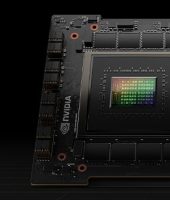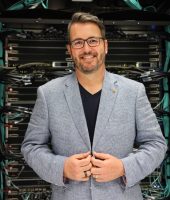Our first decade following in Joe Pawsey’s footsteps
In our first decade, the Pawsey Supercomputing Research Centre has contributed to revealing the mysteries of the Universe: finding slowly spinning neutron stars, weighing galaxies to identify dark matter, finding gravitational waves, even hunting for signs of interstellar civilisations.
These projects and many more are possible today because of the legacy of Joseph L Pawsey, the father of radio astronomy in Australia. In WW2 he developed radio and radar technologies for CSIRO, Australia’s national science agency. In 1945 he turned military radars to the Sun and stars, and for the next 16 years built the foundations of radio astronomy in Australia.
Today, as we launch a new biography of Pawsey, written by Miller Goss, Claire Hooker and Ron Ekers, it is a good opportunity to look at the impact on radio astronomy of the supercomputing centre that bears his name.
Joe Pawsey and the Founding of Australian Radio Astronomy can be purchased here: https://link.springer.com/book/10.1007/978-3-031-07916-0
Modern astronomy is driven by data, a lot of it. So the Pawsey Supercomputing Research Centre has become an essential tool for astronomers.
The Centre, for example, helped reveal mysterious objects such as a slowly spinning neutron star that had been predicted to exist theoretically but never observed.
PhD candidate Tyrone O’Doherty and Curtin University Astrophysicist Dr Natasha Hurley-Walker identified the object using the MWA, a low-frequency radio telescope in outback WA, but the strings of numbers they collected only emerged as pictures thanks to the power of the Pawsey’s Cray XC30 supercomputer system known as Galaxy.
Pawsey has also helped astronomers work out how galaxies evolve, a study that is fundamental to understanding our place in the Universe.
“We’re building a model that will effectively let us run the Universe in reverse, giving us unique insights into where we’ve come from,” Dr Claudia Lagos of ICRAR and the University of Western Australia, said.
It was a Herculean task – more than 30 million CPU hours to calculate the movement and interactions of a billion particles under gravity over time, and up to 40 million CPU hours if the hydrodynamics are considered. Thousands of simulations were run to test different assumptions and physical parameters.
Pawsey has also been at the forefront of the search for dark matter – the missing element to the Universe we know is there but cannot see. That requires huge computing power to analyse the massive amount of data produced by CSIRO’s ASKAP radio telescope.
In her study to compare the mass and spin of galaxies to calculate the amount of dark matter present, Dr Karen Lee-Waddell of CSIRO (and now Director of the Australian SKA Regional Centre), streamed four terabytes of data an hour for 12 hours at a time.
“That’s just raw data – the signal from the sky. We have to do a lot of computations and processing to get useable data out of that. That’s where Pawsey comes in. We take these several terabytes of data and make insightful images of galaxies,” she said.
Pawsey has also been on hand to uncover the very fabric of the Universe through work such as that of Professor Linqing Wen and her team at the OzGrav ARC Centre of Excellence for Gravitational Wave Discovery at the University of Western Australia, to improve how we detect gravitational waves.
She acknowledges that her work goes hand-in-hand with Pawsey.
“We’ve been working with Pawsey for a while now and we hope to continue that relationship in the future. We’re at the point now where we can collect so much data but what we can do with it is dependent on how powerful our computers are.”
The Centre has also helped chase answers to some of the most fundamental questions of our existence, even the most fundamental of all – are we alone in the Universe?
Dr Chenoa Tremblay, together with Professor Steven Tingay from the Curtin University node of the International Centre for Radio Astronomy Research (ICRAR), scanned a patch of sky with over 10 million stars looking for technosignatures — an obvious sign of intelligent life. While she didn’t discover any in that sample, Dr Tremblay continues her search for signs of alien life, work that would be impossible without Pawsey.
“Searching for technosignatures and molecules means…compiling more than 17 hours worth of information on the sky, equivalent to hundreds of terabytes of data. On a standard laptop, processing and analysing this data would take more than 25 years,” Dr Tremblay said.
With the construction of the international SKA telescopes now underway, Pawsey is planning for the next big challenge. The SKA-low telescope in Australia will generate petabits of data every second. Filtering, analysing and sharing that data with the global community will push supercomputing to the limit.
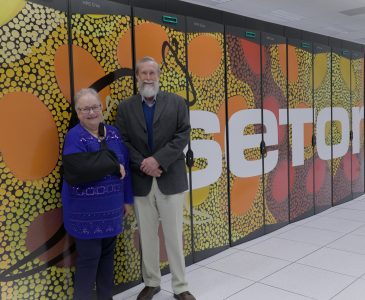
Joe Pawsey's son, Hastings, and daughter-in-law, Liz in front of Setonix, the flagship supercomputer at the Pawsey Supercomputing Research Centre
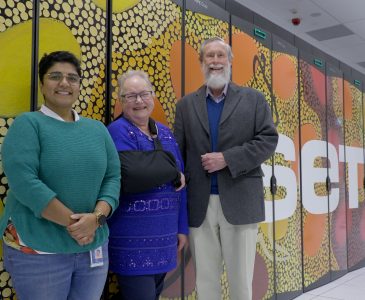
Joe Pawsey's son, Hastings, and daughter-in-law, Liz, with Aditi, Pawsey's Marketing and Events Manager, in front of Setonix, the flagship supercomputer at the Pawsey Supercomputing Research Centre

Joe Pawsey's son, Hastings, and daughter-in-law, Liz, in front of Pawsey branding on the Setonix supercomputer

Mark Stickells, Executive Director at the Pawsey Supercomputing Research Centre, welcoming guests to the Pawsey book launch
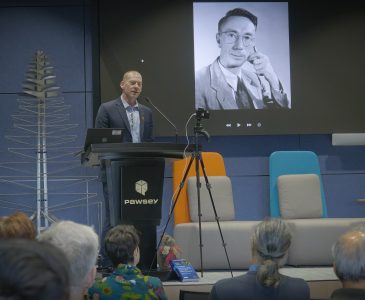
Prof. Steven Tingay, Deputy Executive Director of ICRAR, MC of the Pawsey book launch
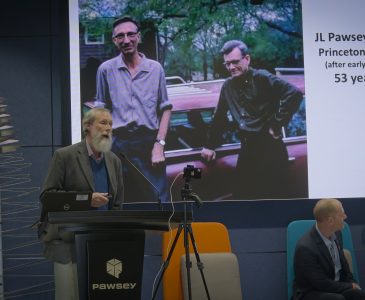
Hastings Pawsey, son of Joseph Pawsey, giving opening remarks at the Pawsey book launch
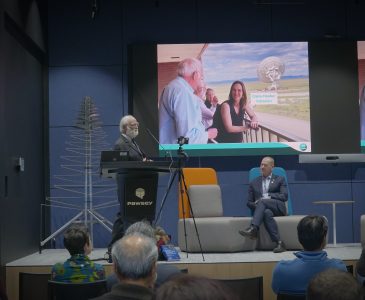
Ron Ekers, co-author of the book, giving remarks at the Pawsey book launch
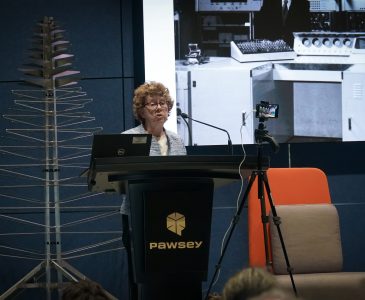
Prof. Elaine Sadler, CSIRO and the University of Sydney, giving remarks at the Pawsey book launch
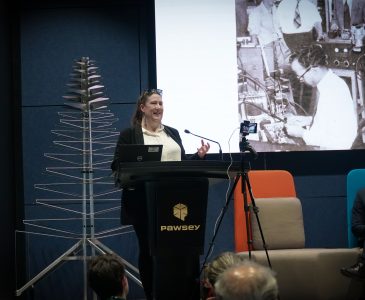
Melanie Johnston-Hollitt, Director at Curtin Institute for Data Science & Australian Space Data Analysis Facility, giving remarks at the Pawsey book launch
